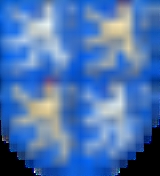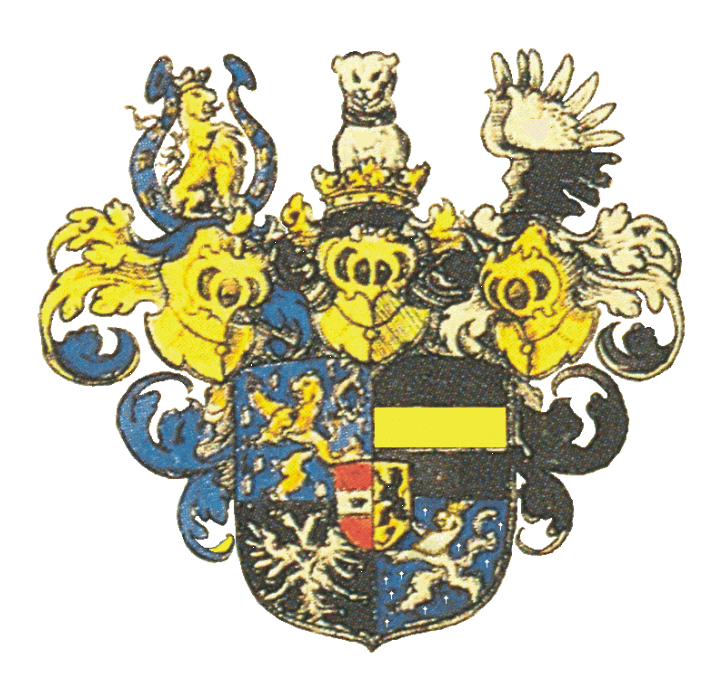
Nassau-Saarbrücken
Encyclopedia
Nassau-Saarbrücken was a county
of the Holy Roman Empire
in the Upper Rhenish Circle
. It belonged to the Walram branch of the House of Nassau
.

 Around the year 1080 Count Sigibert in the Franconian
Around the year 1080 Count Sigibert in the Franconian
Saargau was vested with the whole possessions of the bishop of Metz along the Saar river, the Rhine and in Alsace
as a fiefdom. In 1123 his son uses the title of "Count of Saarbrücken". In 1180 the county was divided into two parts, when the territories along the Rhine were separated to form the basis of the County of Zweibrücken
. The Alsatian possessions had been lost already around 1120.
About 1240 Count Simon III of Saarbrücken died without male heirs, however his daughter Mathilda managed to secure her right of succession by marrying Count Simon of Commercy
who from 1271 called himself Count of Saarbrücken-Commercy. With the death of Count John II in 1381 the male line ended again. As his daughter Johanna had married Count John I of Nassau-Weilburg
in 1353, their son Philipp I inherited the County of Saarbrücken.
 Philipp I ruled both Nassau-Saarbrücken and Nassau-Weilburg and in 1393 inherited through his wife Johanna of Hohenlohe
Philipp I ruled both Nassau-Saarbrücken and Nassau-Weilburg and in 1393 inherited through his wife Johanna of Hohenlohe
the lordships Kirchheimbolanden
and Stauf. He also received half of Nassau-Ottweiler
in 1393 and other territories later during his reign. After his death in 1429 the territories around Saarbrücken and along the Lahn
were kept united until 1442, when they were again divided among his sons into the lines Nassau-Saarbrücken (west of the Rhine) and Nassau-Weilburg (east of the Rhine), the so called Younger line of Nassau-Weilburg.
In 1507 Count John Ludwig I significantly enlarged his territory by marrying Catharine, the daughter of the last Count of Moers-Saarwerden and in 1527 inherited the County of Sarrewerden
including the lordship of Lahr
. Though after his death in 1544 the county was split into three parts, the three lines (Ottweiler, Saarbrücken proper and Kirchheim) were all extinct in 1574 and all of the Nassau-Saarbrücken was united with Nassau-Weilburg until the year 1629. This new division however was not executed until the Thirty Years War was over and in 1651 three counties were established: Nassau-Idstein, Nassau-Weilburg and Nassau-Saarbrücken.
Only eight years later, Nassau-Saarbrücken was again divided into:
By 1728 Nassau-Saarbrücken was united with Nassau-Usingen which had inherited Nassau-Ottweiler and Nassau-Idstein. In 1735 Nassau-Usingen was divided again into Nassau-Usingen and Nassau-Saarbrücken. In 1797 Nassau-Usingen finally inherited Nassau-Saarbrücken, it was (re-)unified with Nassau-Weilburg and raised to the Duchy of Nassau in 1806. The first Duke of Nassau was Frederick August of Nassau-Usingen who died in 1816. Wilhelm, Duke of Nassau-Weilburg inherits the Duchy of Nassau.
The coat of arms
combined the lion of the counts of the Saargau with the crosses of the house of Commercy, and was used when the coat of arms of Saarland
was created.
County
A county is a jurisdiction of local government in certain modern nations. Historically in mainland Europe, the original French term, comté, and its equivalents in other languages denoted a jurisdiction under the sovereignty of a count A county is a jurisdiction of local government in certain...
of the Holy Roman Empire
Holy Roman Empire
The Holy Roman Empire was a realm that existed from 962 to 1806 in Central Europe.It was ruled by the Holy Roman Emperor. Its character changed during the Middle Ages and the Early Modern period, when the power of the emperor gradually weakened in favour of the princes...
in the Upper Rhenish Circle
Upper Rhenish Circle
The Upper Rhenish Circle was an Imperial Circle of the Holy Roman Empire established in 1500 on the territory of the former Duchy of Upper Lorraine and large parts of Rhenish Franconia including the Swabian Alsace region and the Burgundian duchy of Savoy....
. It belonged to the Walram branch of the House of Nassau
House of Nassau
The House of Nassau is a diversified aristocratic dynasty in Europe. It is named after the lordship associated with Nassau Castle, located in present-day Nassau, Rhineland-Palatinate, Germany. The lords of Nassau were originally titled Count of Nassau, then elevated to the princely class as...
.
County of Saarbrücken


Duchy of Franconia
The Duchy of Franconia was one of the stem duchies of Germany during the formative period of the Holy Roman Empire in the 10th century, part of former Frankish Austrasia.But unlike the others Franconia did not evolve into a stable political entity...
Saargau was vested with the whole possessions of the bishop of Metz along the Saar river, the Rhine and in Alsace
Alsace
Alsace is the fifth-smallest of the 27 regions of France in land area , and the smallest in metropolitan France. It is also the seventh-most densely populated region in France and third most densely populated region in metropolitan France, with ca. 220 inhabitants per km²...
as a fiefdom. In 1123 his son uses the title of "Count of Saarbrücken". In 1180 the county was divided into two parts, when the territories along the Rhine were separated to form the basis of the County of Zweibrücken
Palatinate-Zweibrücken
Palatinate-Zweibrücken is a former state of the Holy Roman Empire. Its capital was Zweibrücken.-Overview:→ History before 1394 see main article County of Zweibrücken→ History before 1444 see main article County of Veldenz...
. The Alsatian possessions had been lost already around 1120.
About 1240 Count Simon III of Saarbrücken died without male heirs, however his daughter Mathilda managed to secure her right of succession by marrying Count Simon of Commercy
Commercy
Commercy is a commune in the Meuse department in Lorraine in north-eastern France.It is the home of the madeleines referred to by Marcel Proust in A la Recherche du Temps Perdu.-History:...
who from 1271 called himself Count of Saarbrücken-Commercy. With the death of Count John II in 1381 the male line ended again. As his daughter Johanna had married Count John I of Nassau-Weilburg
John I of Nassau-Weilburg
John I of Nassau-Weilburg was Count of Nassau-Weilburg from 1355 to 1371.John I was the second son of Count Gerlach I of Nassau-Wiesbaden and Agnes of Hesse, granddaughter of Henry I, Landgrave of Hesse. On Gerlach I abdication in 1346, John and his brothers divided the family lands...
in 1353, their son Philipp I inherited the County of Saarbrücken.
County of Nassau-Saarbrücken

Hohenlohe
Hohenlohe is the name of a German princely family and the name of their principality.At first rulers of a county, its two branches were raised to the rank of principalities of the Holy Roman Empire in 1744 and 1764 respectively; in 1806 they lost their independence and their lands formed part of...
the lordships Kirchheimbolanden
Kirchheimbolanden
Kirchheimbolanden, the capital of Donnersbergkreis, is a town in Rhineland-Palatinate, south-western Germany. It is situated approx. 25 km west of Worms, and 30 km north-east of Kaiserslautern. The first part of the name, Kirchheim, dates back to 774. It became a town in 1368, and the...
and Stauf. He also received half of Nassau-Ottweiler
Ottweiler
Ottweiler is a municipality, former seat of the district of Neunkirchen, in Saarland, Germany. It is situated on the river Blies, approx. 7 km north of Neunkirchen, and 25 km northeast of Saarbrücken.The town is notable for the Ottweiler porcelain....
in 1393 and other territories later during his reign. After his death in 1429 the territories around Saarbrücken and along the Lahn
Lahn
The Lahn River is a -long, right tributary of the Rhine River in Germany. Its course passes through the federal states of North Rhine-Westphalia , Hesse , and Rhineland-Palatinate ....
were kept united until 1442, when they were again divided among his sons into the lines Nassau-Saarbrücken (west of the Rhine) and Nassau-Weilburg (east of the Rhine), the so called Younger line of Nassau-Weilburg.
In 1507 Count John Ludwig I significantly enlarged his territory by marrying Catharine, the daughter of the last Count of Moers-Saarwerden and in 1527 inherited the County of Sarrewerden
Sarrewerden
Sarrewerden is a commune in the Bas-Rhin department in Alsace in north-eastern France.-References:*...
including the lordship of Lahr
Lahr
Lahr is a city in western Baden-Württemberg, Germany, approximately 38 km north of Freiburg in Breisgau and 100 km south of Karlsruhe...
. Though after his death in 1544 the county was split into three parts, the three lines (Ottweiler, Saarbrücken proper and Kirchheim) were all extinct in 1574 and all of the Nassau-Saarbrücken was united with Nassau-Weilburg until the year 1629. This new division however was not executed until the Thirty Years War was over and in 1651 three counties were established: Nassau-Idstein, Nassau-Weilburg and Nassau-Saarbrücken.
Only eight years later, Nassau-Saarbrücken was again divided into:
- Nassau-Saarbrücken proper, fell to Nassau-OttweilerOttweilerOttweiler is a municipality, former seat of the district of Neunkirchen, in Saarland, Germany. It is situated on the river Blies, approx. 7 km north of Neunkirchen, and 25 km northeast of Saarbrücken.The town is notable for the Ottweiler porcelain....
in 1723 - Nassau-OttweilerOttweilerOttweiler is a municipality, former seat of the district of Neunkirchen, in Saarland, Germany. It is situated on the river Blies, approx. 7 km north of Neunkirchen, and 25 km northeast of Saarbrücken.The town is notable for the Ottweiler porcelain....
, fell to Nassau-UsingenNassau-UsingenNassau-Usingen was a county of the Holy Roman Empire in the Upper Rhenish Circle that became a principality in 1688.The origin of the county lies in the medieval county of Weilnau that was acquired by the counts of Nassau-Weilburg in 1602....
in 1728 - Nassau-UsingenNassau-UsingenNassau-Usingen was a county of the Holy Roman Empire in the Upper Rhenish Circle that became a principality in 1688.The origin of the county lies in the medieval county of Weilnau that was acquired by the counts of Nassau-Weilburg in 1602....
By 1728 Nassau-Saarbrücken was united with Nassau-Usingen which had inherited Nassau-Ottweiler and Nassau-Idstein. In 1735 Nassau-Usingen was divided again into Nassau-Usingen and Nassau-Saarbrücken. In 1797 Nassau-Usingen finally inherited Nassau-Saarbrücken, it was (re-)unified with Nassau-Weilburg and raised to the Duchy of Nassau in 1806. The first Duke of Nassau was Frederick August of Nassau-Usingen who died in 1816. Wilhelm, Duke of Nassau-Weilburg inherits the Duchy of Nassau.
The coat of arms
Coat of arms
A coat of arms is a unique heraldic design on a shield or escutcheon or on a surcoat or tabard used to cover and protect armour and to identify the wearer. Thus the term is often stated as "coat-armour", because it was anciently displayed on the front of a coat of cloth...
combined the lion of the counts of the Saargau with the crosses of the house of Commercy, and was used when the coat of arms of Saarland
Coat of arms of Saarland
This article is about the coat of arms of the German state of Saarland.The coat of arms of Saarland is parted per cross:*The first quarter shows the coat of arms of the prince of Nassau-Saarbrücken, a silver lion with golden crown, between nine crosses agent. The shield is blue...
was created.
Regents
| reign | name | born | died | family |
|---|---|---|---|---|
| 1381-1429 | Philipp I | 1368 | 2-7-1429 | |
| 1429/42-1472 | John II | 4-4-1423 | 25-7-1472 | son |
| 1472-1545 | John Ludwig | 19-10-1472 | 4-6-1545 | son |
| 1545-1554 | Philipp | 25-7-1509 | 19-6-1554 | son |
| 1554-1574 | John III | 5-4-1511 | 23-11-1574 | brother |
| 1574-1602 | Philipp IV | 14-10-1542 | 12-3-1602 | son of Philipp III of Nassau-Weilburg |
| 1602-1627 | Louis II Louis II, Count of Nassau-Weilburg Louis II of Nassau-Weilburg was a count of Nassau-Weilburg.- Life :Louis was the eldest son of Count Albert of Nassau-Weilburg-Ottweiler and Countess Anna of Nassau-Dillenburg. His family moved in 1575 from Weilburg to Ottweiler... |
9-8-1565 | 8-11-1627 | brother's son |
| 1625/7-1640 | William Louis William Louis, Count of Nassau-Saarbrücken William Louis of Nassau-Saarbrücken , was a Count of Saarbrücken.- Life :His parents were Louis II of Nassau-Weilburg and Landgravine Anna Maria of Hesse-Kassel... |
18-12-1590 | 22-8-1640 | son |
| 1640-1642 | Kraft | 7-11-1621 | 14-7-1642 | son |
| 1642-1659 | John Ludwig | 24-5-1625 | 9-2-1690 | brother |
| 1642-1677 | Gustav Adolph Gustav Adolph, Count of Nassau-Saarbrücken Gustav Adolf of Nassau-Saarbrücken was Count of Saarbrücken and Major General at the Rhine of the Holy Roman Empire of German Nation.... |
27-3-1632 | 9-10-1677 | brother |
| 1677-1713 | Louis Crato Louis Crato, Count of Nassau-Saarbrücken Louis Crato, Count of Nassau-Saarbrücken was the son of Count Gustav Adolph of Nassau-Saarbrücken and Clara Eleanor, Countess of Hohenlohe-Neuenstein. He was educated at Neuenstein with his uncle, Count Wolfgang Julius of Hohenlohe-Neuenstein, and later in Tübingen... |
28-3-1663 | 14-2-1713 | son |
| 1713-1723 | Charles Louis Charles Louis, Count of Nassau-Saarbrücken Charles Louis, Count of Nassau-Saarbrücken was the son of Count Gustav Adolf of Nassau-Saarbrücken and Countess Clara Eleanor of Hohenlohe-Neuenstein.... |
6-1-1665 | 6-12-1723 | brother |
| 1723-1728 | Frederick Ludwig | 3-11-1651 | 25-5-1728 | son of John Ludwig |
| 1728/35/42-1768 | William Henry | 6-3-1718 | 24-7-1768 | son of Wolrad of Nassau-Usingen |
| 1768-1794 | Ludwig | 3-1-1745 | 2-3-1794 | son |
| 1794-1797 | Henry | 9-3-1768 | 27-4-1797 | son |
Sources
- The Dutch Nassau-Saarbrücken and the German Nassau-Saarbrücken Wikipedia articles
- The divisions of the House of Nassau chart
- Sante, Wilhelm. Geschichte der Deutschen Länder - Territorien-Ploetz. Würzburg 1964.
- Köbler, Gerhard. Historisches Lexikon der Deutschen Länder. München 1988.

